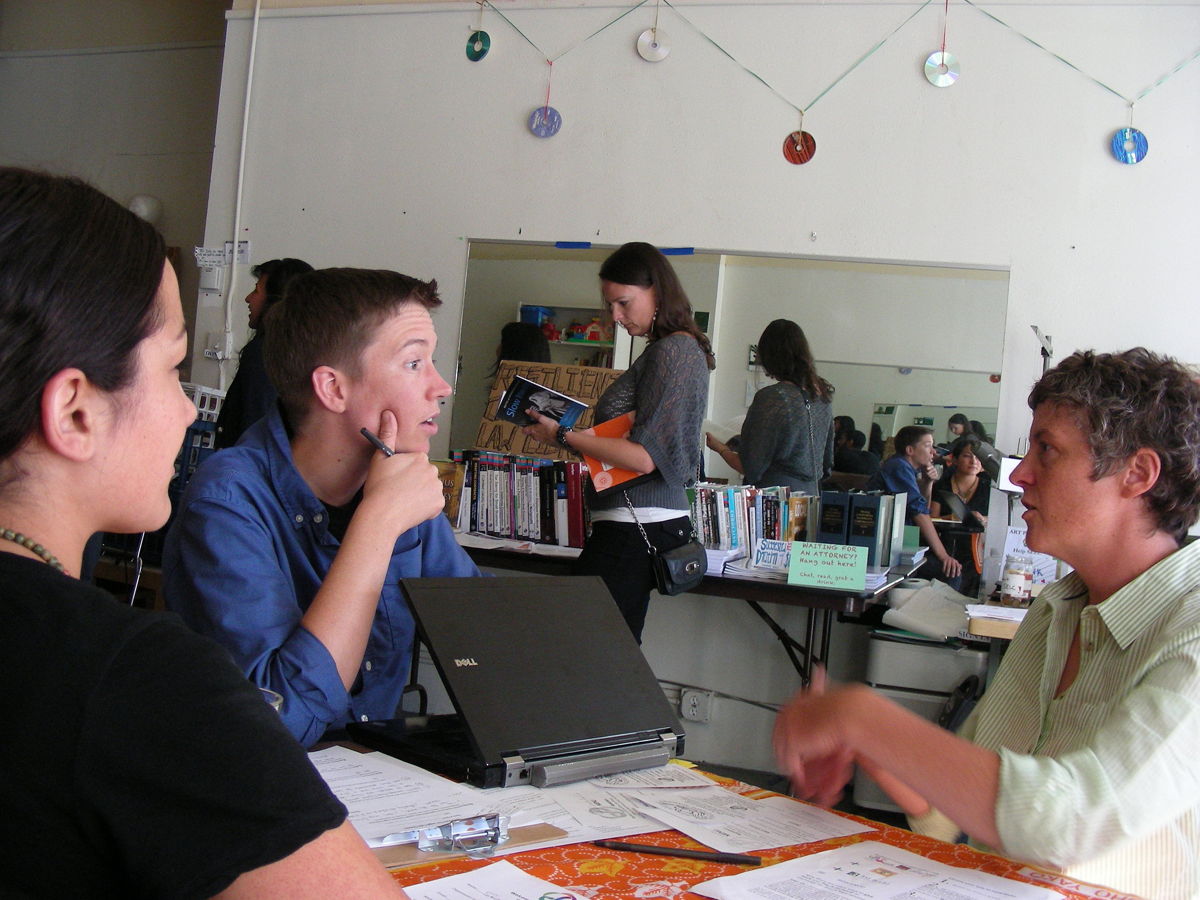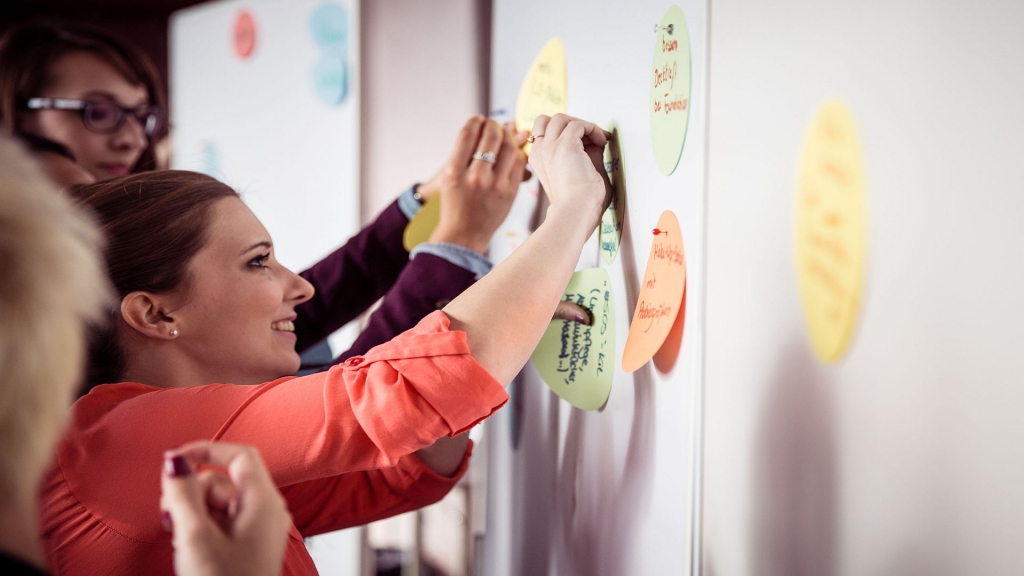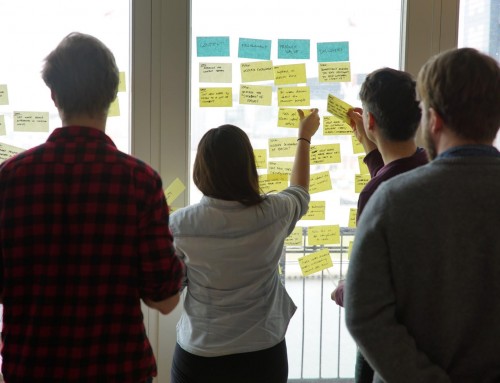Five to Fold
Main TakeawaysReading Time: 5 minutes Five-to-Fold is a method for effective, holistic group decision-making. It invites, honors, and integrates all individual perspectives. Five-to-Fold is intended as a process for genuine decision-making, rather than for gathering feedback or informing a decision to be made elsewhere.
Description of Five to Fold
Five to Fold is a facilitation format I use frequently. Five-to-Fold is a method for effective, holistic group decision-making. In its short version, Five-to-Fold is the well known Thumb Voting resp. Five-Finger-Voting. In the long version, Five-to-Fold is an elaborate decision-making facilitation process.
A major strength of Five-to-Fold is that it invites, honors, and integrates all individual perspectives, including intuitive "minority" perspectives, into practical decision-making in clear, effective ways grounded in individual responsibility. Five-to-Fold fosters open and honest communication, and continuous contact between individual and organisational purpose/essence. Five-to-Fold uses Circle Process facilitation to present and discuss the proposals.
When a group is asked to take a decision, the members try to find a common level of agreement by either democratic voting or consensus-based decision-making. In case of consensus-based decisioning seldom all people agree equally to the decision found. Instead, they commit themselves to a level of personal agreement.
Prerequisites of the Process
- Shared Decision-Making Authority: the group or parts of it holds the authority to make decisions as an entity. Five-to-Fold is intended as a process for genuine decision-making, rather than for gathering feedback or informing a decision to be made elsewhere.
- Whole Group Wisdom: the diversity of participants is valued as essential to a wise decision.
- Group Purpose: Each participant is inclined to be an active part of finding practical group decisions.
- Clear Prerequisites: participants consider a proposal in the context of organisational and/or meeting constraints/prerequisites.
- Facilitation: a facilitator guides the Five to Fold process. The facilitator may or may not be a member of the decision-making group. The facilitator guides the process without engaging in the content discussion or participating in the "finger vote."
- Proposal Development: the process begins with a clear, carefully developed proposal to be considered for the group decision. The proposal may be revised during the process.
- Proposal Sponsorship: each proposal to be considered is presented and shepherded by a sponsor. Every participant can be a sponsor to present a proposal.
- When It's Not Over, It's Not Over: sufficient time is required for a Five-to-Fold decision to be created. Experience has shown that 90 minutes is a good initial guideline for a deep and important proposal. Each group will discover in practice how to manage the time for their decision-making circles.
- Whoever Comes are the Right People: whoever is present for the meeting participates in the process. Five to Fold is an inclusive process. Whoever is present takes part in the entire process, including the "finger-voting."
- Hopes and Fears: allow time for hopes and fears to emerge within the process. Hopes and Fears can and do emerge during the decision-making process.
Because hopes and fears are most relevant to a particular proposal they most naturally emerge during the Talking Circle portion of the decision-making process.
Rules of Five to Fold
- Physical Design:
the participants are seated in a circle, with no table or other obstacles in the center. Flipchart paper is available to support different learning styles.
- Welcome:
the facilitator welcomes the participants and values their diversity.
- Check-In:
perform a warm-up exercise to check participants in.
- Givens And Purpose: the givens for the meeting, and/or for the organisation, are shared with all participants. .
- Presentation Of Proposal:
- The facilitator introduces the proposal sponsor(s) and reminds the group that it is the sponsor who will be shepherding the proposal through the process.
- Until a proposal becomes a decision, it "belongs" to the Sponsor, and it is only the sponsor who can choose to make any revisions to the proposal during the process.
The sponsor is free as well to withdraw the proposal during the process, perhaps to develop further and present at a later date.
- The sponsor(s) present the proposal to the group.
- The sponsor shares the proposal draft, both verbally aloud and in writing on flip-chart paper.
- Clarifying Questions:
- The facilitator invites clarifying questions from any participant to the Proposal Sponsor(s). In this step, the facilitator guides the process tightly.
- The facilitator reminds participants that they will be invited to share their perspective on the proposal during the upcoming talking circle, and that now is the time to ask focused specific clarifying questions about the proposal as worded and presented.
- The Sponsor(s) have time to respond thoughtfully to each question.
- When all clarifying questions have been asked and responded to, the facilitator invites the Sponsor(s) to make any revisions they wish to make to the proposal as written.
- Talking Circle: The facilitator invites the participants to share any thoughts or feelings on the proposal and how it relates to the group and its purpose, even if they are not fully formed.
- Transition:
When the talking circle is complete, the facilitator shares that it is time to transition to the Five to Fold finger-vote.
In case of complex decisions, this is a tricky moment for the facilitator and the group. It sometimes happens that the sponsor wishes move to a revision of the proposal in response to the previous group discussion or the group wants to dive again into a new discussion.
For this important is that the facilitator keeps on track and proceeds to the finger-vote.
- Finger-Vote:
The facilitator shares the directions for the finger-vote: each person in the circle will demonstrate their support for the proposal as presented with their hands, by holding up a number of fingers on one hand, or by showing a folded fist.
- Five fingers held up means that you fully support the proposal and that you will take leadership in implementing the proposal.
- Four fingers means that you strongly support the proposal, but that you are not necessarily in a leadership role for implementation.
- Three fingers demonstrates solid acceptance of the proposal.
- Two fingers means that you have some important reservations about the proposal, but that you will support its implementation.
- One finger means that you have very serious reservations about the proposal, that in some important way the proposal feels at odds with the purpose and needs of the group at this time.
- But by holding up one finger, you are not blocking the proposal becoming a group decision, and you are committing not to subvert the decision in any way and to communicate openly and honestly about your reservations.
Note:
- A Fold means that you choose to block the proposal becoming a decision at this time, because you believe with head, heart, spirit, and/or intuition, that the proposal as presented is damaging to the purpose of the group.
- Remember that a Fold does not indicate a failure of the process, but rather an essential possible outcome of the process.
- Recording:
At this time, the fingers may be recorded for the record, or not, according to desired or established group practice. Fingers may be recorded generically, or attributed to specific individuals.
- Checking In With Twos, Ones, And Folds:
If no one shows folded hands, the facilitator states that the proposal has become a decision, and then always invites those who showed one or two fingers to say a few words about their reservations, if they choose.
It is useful to record these reservations when a report is being made of the meeting decisions. This honors the unity of the group and often opens doors to addressing these concerns in the ongoing work.
If someone has folded, the facilitator states that the proposal has not become a decision and invites the person(s) who folded to speak. The facilitator reminds the group that space is open for all participants to take responsibility to work together in the days to come to create a resolution to the situation.
- Next Steps / Actions Taken:
The facilitator opens space for establishing next steps. When a proposal has become a decision, the sponsor or another leader may schedule a follow-up implementation meeting or other steps. If there has been a fold, a follow-up meeting to consider the issue may be scheduled, as desired.
When to use Five to Fold
- There is an issue to solve.
- There is a proposal (and alternatives) as a solution.
- There is a group, the participants, that has the authority to decide.
Facilitator Role
- Guides the process.
- Explains the prerequisites of the method.
- May or may not be a member of the decision-making group.
- Is unattached to outcome.
- Does not participate in the content of the process or the "finger-vote".
- Helps the discussions stay focused.
- Moderates in case of conflict and disagreement.
- Helps group members identify areas of agreement and disagreement.
- Brings in points of view that haven’t been talked about.
- Creates opportunities for everyone to participate.
- Focuses and helps to clarify the discussion.
- Summarise key points in the discussion, or ask others to do so.
Five to Fold
Main Takeaways
Reading Time: 5 minutes Five-to-Fold is a method for effective, holistic group decision-making. It invites, honors, and integrates all individual perspectives. Five-to-Fold is intended as a process for genuine decision-making, rather than for gathering feedback or informing a decision to be made elsewhere.
Description of Five to Fold
Five to Fold is a facilitation format I use frequently. Five-to-Fold is a method for effective, holistic group decision-making. In its short version, Five-to-Fold is the well known Thumb Voting resp. Five-Finger-Voting. In the long version, Five-to-Fold is an elaborate decision-making facilitation process.A major strength of Five-to-Fold is that it invites, honors, and integrates all individual perspectives, including intuitive "minority" perspectives, into practical decision-making in clear, effective ways grounded in individual responsibility. Five-to-Fold fosters open and honest communication, and continuous contact between individual and organisational purpose/essence. Five-to-Fold uses Circle Process facilitation to present and discuss the proposals.
When a group is asked to take a decision, the members try to find a common level of agreement by either democratic voting or consensus-based decision-making. In case of consensus-based decisioning seldom all people agree equally to the decision found. Instead, they commit themselves to a level of personal agreement.
Prerequisites of the Process
- Shared Decision-Making Authority: the group or parts of it holds the authority to make decisions as an entity. Five-to-Fold is intended as a process for genuine decision-making, rather than for gathering feedback or informing a decision to be made elsewhere.
- Whole Group Wisdom: the diversity of participants is valued as essential to a wise decision.
- Group Purpose: Each participant is inclined to be an active part of finding practical group decisions.
- Clear Prerequisites: participants consider a proposal in the context of organisational and/or meeting constraints/prerequisites.
- Facilitation: a facilitator guides the Five to Fold process. The facilitator may or may not be a member of the decision-making group. The facilitator guides the process without engaging in the content discussion or participating in the "finger vote."
- Proposal Development: the process begins with a clear, carefully developed proposal to be considered for the group decision. The proposal may be revised during the process.
- Proposal Sponsorship: each proposal to be considered is presented and shepherded by a sponsor. Every participant can be a sponsor to present a proposal.
- When It's Not Over, It's Not Over: sufficient time is required for a Five-to-Fold decision to be created. Experience has shown that 90 minutes is a good initial guideline for a deep and important proposal. Each group will discover in practice how to manage the time for their decision-making circles.
- Whoever Comes are the Right People: whoever is present for the meeting participates in the process. Five to Fold is an inclusive process. Whoever is present takes part in the entire process, including the "finger-voting."
- Hopes and Fears: allow time for hopes and fears to emerge within the process. Hopes and Fears can and do emerge during the decision-making process.
Because hopes and fears are most relevant to a particular proposal they most naturally emerge during the Talking Circle portion of the decision-making process.
Rules of Five to Fold
- Physical Design:
the participants are seated in a circle, with no table or other obstacles in the center. Flipchart paper is available to support different learning styles. - Welcome:
the facilitator welcomes the participants and values their diversity. - Check-In:
perform a warm-up exercise to check participants in. - Givens And Purpose: the givens for the meeting, and/or for the organisation, are shared with all participants. .
- Presentation Of Proposal:
- The facilitator introduces the proposal sponsor(s) and reminds the group that it is the sponsor who will be shepherding the proposal through the process.
- Until a proposal becomes a decision, it "belongs" to the Sponsor, and it is only the sponsor who can choose to make any revisions to the proposal during the process.
The sponsor is free as well to withdraw the proposal during the process, perhaps to develop further and present at a later date. - The sponsor(s) present the proposal to the group.
- The sponsor shares the proposal draft, both verbally aloud and in writing on flip-chart paper.
- Clarifying Questions:
- The facilitator invites clarifying questions from any participant to the Proposal Sponsor(s). In this step, the facilitator guides the process tightly.
- The facilitator reminds participants that they will be invited to share their perspective on the proposal during the upcoming talking circle, and that now is the time to ask focused specific clarifying questions about the proposal as worded and presented.
- The Sponsor(s) have time to respond thoughtfully to each question.
- When all clarifying questions have been asked and responded to, the facilitator invites the Sponsor(s) to make any revisions they wish to make to the proposal as written.
- Talking Circle: The facilitator invites the participants to share any thoughts or feelings on the proposal and how it relates to the group and its purpose, even if they are not fully formed.
- Transition:
When the talking circle is complete, the facilitator shares that it is time to transition to the Five to Fold finger-vote.
In case of complex decisions, this is a tricky moment for the facilitator and the group. It sometimes happens that the sponsor wishes move to a revision of the proposal in response to the previous group discussion or the group wants to dive again into a new discussion.
For this important is that the facilitator keeps on track and proceeds to the finger-vote. - Finger-Vote:
The facilitator shares the directions for the finger-vote: each person in the circle will demonstrate their support for the proposal as presented with their hands, by holding up a number of fingers on one hand, or by showing a folded fist.- Five fingers held up means that you fully support the proposal and that you will take leadership in implementing the proposal.
- Four fingers means that you strongly support the proposal, but that you are not necessarily in a leadership role for implementation.
- Three fingers demonstrates solid acceptance of the proposal.
- Two fingers means that you have some important reservations about the proposal, but that you will support its implementation.
- One finger means that you have very serious reservations about the proposal, that in some important way the proposal feels at odds with the purpose and needs of the group at this time.
- But by holding up one finger, you are not blocking the proposal becoming a group decision, and you are committing not to subvert the decision in any way and to communicate openly and honestly about your reservations.
Note:
- A Fold means that you choose to block the proposal becoming a decision at this time, because you believe with head, heart, spirit, and/or intuition, that the proposal as presented is damaging to the purpose of the group.
- Remember that a Fold does not indicate a failure of the process, but rather an essential possible outcome of the process.
- Recording:
At this time, the fingers may be recorded for the record, or not, according to desired or established group practice. Fingers may be recorded generically, or attributed to specific individuals. - Checking In With Twos, Ones, And Folds:
If no one shows folded hands, the facilitator states that the proposal has become a decision, and then always invites those who showed one or two fingers to say a few words about their reservations, if they choose.
It is useful to record these reservations when a report is being made of the meeting decisions. This honors the unity of the group and often opens doors to addressing these concerns in the ongoing work.
If someone has folded, the facilitator states that the proposal has not become a decision and invites the person(s) who folded to speak. The facilitator reminds the group that space is open for all participants to take responsibility to work together in the days to come to create a resolution to the situation. - Next Steps / Actions Taken:
The facilitator opens space for establishing next steps. When a proposal has become a decision, the sponsor or another leader may schedule a follow-up implementation meeting or other steps. If there has been a fold, a follow-up meeting to consider the issue may be scheduled, as desired.
When to use Five to Fold
- There is an issue to solve.
- There is a proposal (and alternatives) as a solution.
- There is a group, the participants, that has the authority to decide.
Facilitator Role
- Guides the process.
- Explains the prerequisites of the method.
- May or may not be a member of the decision-making group.
- Is unattached to outcome.
- Does not participate in the content of the process or the "finger-vote".
- Helps the discussions stay focused.
- Moderates in case of conflict and disagreement.
- Helps group members identify areas of agreement and disagreement.
- Brings in points of view that haven’t been talked about.
- Creates opportunities for everyone to participate.
- Focuses and helps to clarify the discussion.
- Summarise key points in the discussion, or ask others to do so.








Leave A Comment